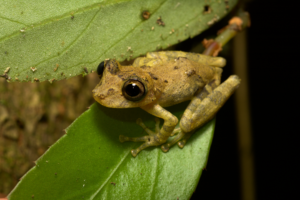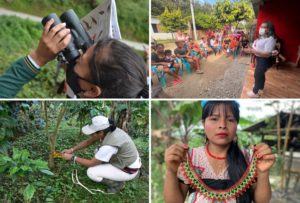Everything is connected: We need a new approach to biodiversity loss
Written by Olivia Nater | Published: May 22, 2024
On International Day for Biological Diversity, we reflect on humanity’s failure to halt the extinction crisis and why we need a new approach to conservation.
A neglected crisis
With increasingly worse climate change impacts unfolding around the world and countless media stories documenting them, no reasonable person can deny the severity of the crisis. There is another environmental emergency on par with climate change in terms of the existential risk it presents, however, that receives far less attention: the escalating loss of biodiversity.
 Biodiversity is the variety of life on our planet, which is integral to the healthy functioning of the ecosystems that sustain us all. Humanity needs biodiversity for clean air and water, food, shelter, and even protection from disease. Unfortunately, despite conservation efforts, we are causing species to go extinct faster than ever before in human history, leading to scientists declaring a sixth mass extinction event.
Biodiversity is the variety of life on our planet, which is integral to the healthy functioning of the ecosystems that sustain us all. Humanity needs biodiversity for clean air and water, food, shelter, and even protection from disease. Unfortunately, despite conservation efforts, we are causing species to go extinct faster than ever before in human history, leading to scientists declaring a sixth mass extinction event.
Failure to tackle the root causes
A paper published in Science last month found that 66 percent of 186 studies looking into the effectiveness of conservation interventions documented either an improvement in the state of biodiversity or a slowed deterioration. While a 66 percent success rate is worth celebrating, it also means that a third of deployed conservation actions failed to protect their target species or habitats from further decline.
Conservation measures can fail due to underfunding, poor design, and/or lack of enforcement, but many are also limited (or short-lived) in their effectiveness because they tend to target the symptoms rather than the root causes of the crisis.
To truly end biodiversity loss, we must tackle the underlying drivers: relentless human population and consumption growth. The more land and resources we appropriate for our own uses, the less is left for the millions of other species we share this planet with. We also directly harvest countless species, from fish to trees. Habitat loss and overexploitation are by far the biggest drivers of biodiversity loss. In addition to those drivers, species are also negatively impacted by climate change, pollution, and the spread of invasive species, all of which are amplified by expanding human populations and unsustainable consumption levels.
A more holistic approach
Population pressure plays a particularly big role in developing countries where consumption levels are still relatively low. Many biodiversity hotspots — areas that are uniquely rich in animal and plant life — are located in areas with rapid human population growth. The biggest driver of deforestation in the Congo Basin, for example, is small-holder agriculture.
The most effective conservation actions are those that address the critical linkages between population, health, and the environment. This so-called “PHE” approach includes efforts to empower local communities and improve people’s health, especially reproductive health. Several of Population Connection’s Global Partners employ this successful model. One of them, Conservation Through Public Health (CTPH) in Uganda, was a pioneer of the PHE (also known as “One Health”) model, playing a key role in pulling mountain gorillas back from the brink of extinction. CTPH activities include the distribution of family planning supplies and information, and training on infectious disease prevention and sustainable livelihoods, such as environmentally-friendly coffee farming. This holistic approach leads to healthier people, a lower risk of disease transmission between humans and wildlife, reduced human population pressure and poverty (thanks to more women having the power to choose the number, timing, and spacing of children), and fewer damaging activities such as deforestation and poaching as people gain less destructive and more lucrative sources of income.

Growing recognition of the efficacy of PHE efforts led to the recent formation of the International Union for Conservation of Nature’s (IUCN) Biodiversity & Family Planning Task Force, which published a guidance document this month on how to incorporate family planning into national biodiversity plans.
Of course, enabling access to modern contraception is just the first step in helping communities protect their natural resources. Many of Population Connection’s Global Partners also emphasize the critical role played by the empowerment of women through education and training. Women for Conservation, for example, works with local women living near Colombia’s biodiversity hotspots to provide workshops and training for family planning as well as conservation education, and sustainable livelihoods.
Women for Conservation Vice President & Conservation Director, Isabella Cortes Lara, explains,
“Our organization recognizes that empowering women has a deep and long-lasting impact on protecting the environment. When women are involved in conservation programs, not only do these programs gain more acceptance from the community, but they also have a greater impact on alleviating poverty and motivating families towards sustainable livelihoods that reduce environmental destruction.”
Taking it global
PHE conservation efforts are generally small-scale and specifically targeted at meeting the needs of local communities, but PHE should also serve as a lens through which to view global environmental crises. Recognizing that human health and wellbeing depend on a healthy environment, and vice versa, helps prioritize conservation efforts and makes them more effective. The achievement of the UN’s Sustainable Development Goals (SDGs), which aim to protect the environment and ensure a good quality of life for all, will depend on whether policymakers recognize these connections, or continue to work in silos.
Population Connection recently co-hosted a UN side event with Population Matters and Population Media Center on the theme of PHE. One of the panelists was Dr. Gladys Kalema-Zikusoka, Founder & CEO of CTPH (and Population Connection board member). Watch the recording below:

